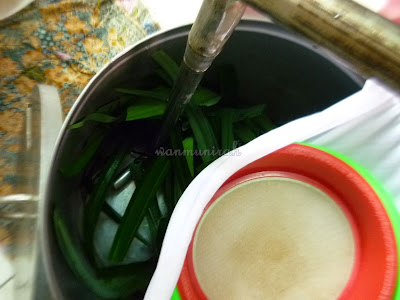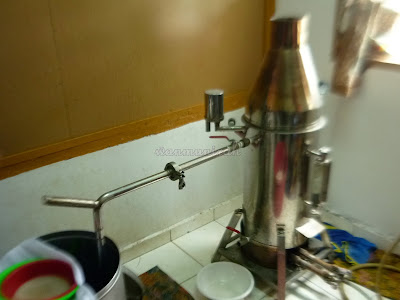During the Jom Jelajah Koperasi (JJK)
Negeri Sembilan 2013 organized by Gaya Travel Magazine and SKM (Suruhanjaya
Koperasi Malaysia or Cooperative Commission of Malaysia) from 21 – 24 October
2013, I was taken to four (out of nine) Homestays in Negeri Sembilan namely
Homestay Pachitan, Homestay Pelegong, Homestay Batang Nyamor and Homestay
Kampung Lonek. Currently, the remaining Homestays in Negeri Sembilan are
Homestay Klawang, Homestay Mudin Hasan, Homestay Gemas, Homestay F’Best and
Homestay Laman Bangkinang.
Homestay Pachitan is located
in the Port Dickson district. The address: Homestay Pachitan, Lot 2006, Kampung
Swah, 71960 Chuah Port Dickson, Negeri Sembilan.
There are 2 alternative routes to
this Homestay. One way is bypassing the Sepang International Circuit and cowboy
town of Sungai Pelek, heading towards Port Dickson, Negeri Sembilan. The road
is a narrow winding road flank by Oil Palm plantations on both sides. The longer
way from Kuala Lumpur is via the normal North-South Highway south bound,
exiting at the Port Dickson toll and heading towards the town of Lukut. There
is a proper signage that shows the directions to Homestay Pachitan.
Upon arrival at Homestay Pachitan, I
was greeted by a welcoming group of “Kompang” boys. I always love this
traditional greeting as it always remind of my own wedding 28 years ago when I
was a blushing bride with my dashing handsome husband. How time flies!
The villagers are the 4th
generation of Javanese from the original Pachitan Village in Central Java,
Indonesia who migrated to this part of West Malaysia one hundred years ago.
Homestay Pachitan is established 6 years ago since 2007 with 35 houses with
total 60 rooms which can accommodate between 100 to120 persons at any one time.
Although there are no traditional houses, river, forest and lake, it attracted
international tourists from Portugal, Australia, Italy and Brazil. The biggest
group is 300 Singaporean for the “Akikah” or sacrifice of cow or sheep during
the Eid Haj.
When I asked the coordinator, Mr
Bunandar Bakat, the meaning of words on the welcome banner “Ojo lali Pachitan Jenengnge, pelik tapi
menarik”, he said “Jangan lupa Pachitan. Namanya pelik tapi menarik”
meaning “Don’t forget Pachitan. The name is weird but interesting”
To me, the name is not intriguing
but what amazed me is the appealing fact that Homestay Pachitan is the no 2
Homestay in Negeri Sembilan, after Homestay Kampung Kg Lonek.
The main activities are rubber
tapping, batik painting, playing local traditional games, cooking demonstration
and cultural performance.
During the JJK at Homestay Pachitan,
I was shown the processing of soya drink and cooking coconut jelly, “rempeyek”,
a snack and “kelepong”, a local name for “buah Melaka”
The process of Soya Drink
Grinding of socked
Soya beans.
Triple strain
using 2 fine sieves and a fine muslin cloth
Residue of soya beans to
be discarded
The soya drink is cooked
by steam from this special machine. It helps to retain the original milky favor
of the soya bean. It is best consumed while it is still fresh and only last for
2 days as it doesn’t contain any preservative. The soya drink is sold at the local night market and also for special functions.
Cooking Coconut Jelly
Ingredients
 |
| Coarse sugar, shredded coconut flesh and strips of jelly / gelatin |
Cooking
It is best eaten chilled during a
hot day.
Cooking “Rempeyek”
Ingredients
Flour mixture
Fried & drained.
Cooking “Kelepong” or "Onde-Onde" or "Buah Melaka"
Ingredients
Cooking
After the cooking demonstration is
our lunch.
After the nourishing meal, I was
taken to visit one of the Foster family’s home. It is a huge mansion.
I understand from Mr Nadzri, the
house owner, he was given RM 3,000.00 to upgrade the toilets for the comfort of
his guests. The Homestay program has full financial and training support from
the Ministry of Tourism and Culture “Kementerian
Pelancongan dan Kebudayaan” and also the Ministry of Rural and Regional
Development “Kementerian Luar Bandar dan
Wilayah”.
During the JJK program, there was no
enough time for a cultural performance as we had to leave for Homestay Pelegong
for the next agenda.
I was fortunate to experience the
Cultural aspects of Homestay Pachitan during the Negeri Sembilan Food Trail
2013 organized by Tourism Malaysia Negeri Sembilan from 12 – 14 November 2013.
Homestay Pachitan has a band of oldies who sings Javanese and modern songs.
There are more
photos in our Company Facebook page – Leisure & Incentive Tours Sdn Bhd. If
you have any inquiry, please call me (Miss Wan) at 03-2260 3667 / 4667 or email
to leisureincentivetours@gmail.com


























































